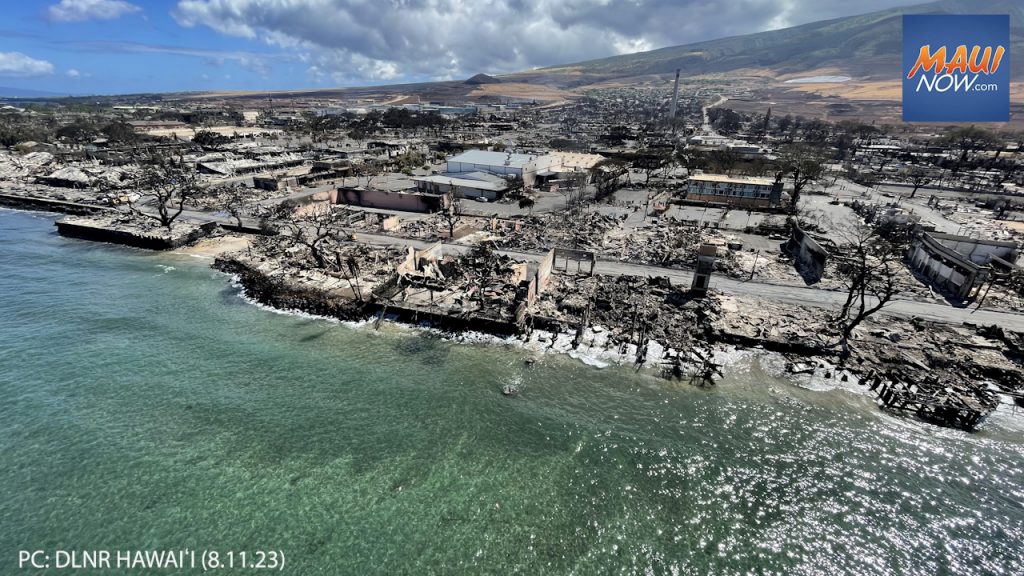Bill to establish Lele Community District Board expected to stall in state House

A controversial bill to establish a nine-member Lele Community District Board for decision-making in rebuilding Lahaina has passed the state Senate, but it will not advance in the House, according to West Maui Rep. Elle Cochran.
Senate Bill 3381 Draft 2 crossed over from the Senate on March 5, and it passed first reading in the House on March 7. Then, it was assigned to three House committees: Water and Land, chaired by Rep. Linda Ichiyama; Judiciary & Hawaiian Affairs, chaired by David Tarnas; and Finance, chaired by Rep. Kyle Yamashita. No committee hearings have been scheduled.
Cochran shared West Maui community concerns about the bill with the committee chairs, and said the measure will not be moving forward in the House. “Mahalo to Chair Ichiyama and Chair Tarnas for listening to the West Maui community,” she said.
Sen. Angus McKelvey, whose District 6 seat includes West Maui, Mā‘alaea, Waikapū and South Maui, introduced the bill with Sen. Donovan Dela Cruz.
When asked Thursday morning about the House decision not to move it forward, McKelvey said: “I respect their decision as it is based on legitimate concerns from the community that much more dialogue is needed than time allows. I’m glad that we had the start of a much-needed conversation — one that last happened over 30 years ago, in how do you shift government spending decisions and control out of Honolulu and into the hands of the community through community self-governance.”
Earlier, in advocating for the bill, McKelvey emphasized the importance of giving the community control over state assets and funding for projects in the rebuilding of Lahaina. Establishing a community authority could allow for vision-based zoning and realignment of planning and permitting to community standards, he said.
Cochran said she has numerous concerns about the bill. However, “to be clear, I am not opposed to a plan for Lahaina, but my concern has been that the West Maui community was not given ample opportunity to participate in the decision-making process and was provided little to no education/outreach/discussion on the far-reaching impacts of this bill,” she said.
Cochran said her specific reservations about the bill included giving the board authority to condemn land and taking planning, development and rebuilding decisions for Lahaina from Maui County and shifting that authority to the state through the nine-member elected board.
The measure setting up the board “lacks the necessary safeguards to protect against undue influence by special interest groups,” she said. And, it “allows the governor to fill any vacancy without legislative, county or community approval.”
Cochran said she also was concerned that the board would be required to create new rules relating to the use, zoning, planning and development of land that “could supersede any and all existing county ordinances and rules.”
“A potential solution could be a Special Improvement District for the burn zone of Lahaina in which all stakeholders (residents and businesses) would have a say in the decision-making and planning for Lahaina,” she said.
That would be in conjunction with West Maui neighborhood boards to include broader community participation, she said.
The bill proposed establishing the new board with elected Lahaina community members under the state Department of Business, Economic Development and Tourism’s Hawaiʻi Community Development Authority.
In the Senate, the measure drew passionate testimony for and against it.
Under the bill, the Lele Community District would be made up of the Lahaina moku, which comprises 29 ahupuaʻa, as noted in the State of Hawaiʻi geographical information system database.
According to the measure, the board’s actions shall result in a community that: “Reflects the values, aspirations and goals of residents; includes a significant number of affordable homes; encourages a thriving, sustainable business sector that includes tourism; and restores community assets, including schools, parks, gathering places and ocean-based recreation.”








